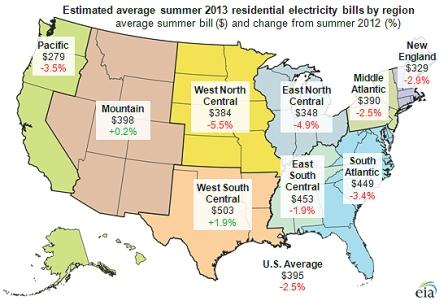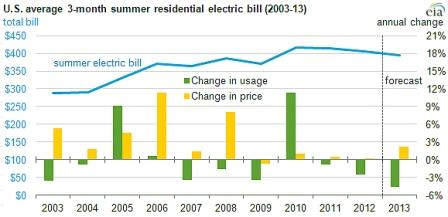There’s nothing like a cold, air-conditioned room to take the edge off a summer day—and to take a bite out of a homeowner’s electricity budget. However, this year there will be less reason to get hot under the collar about your utility invoice than usual. The average U.S. residential summer 2013 electric bill is expected to drop to the lowest level it has reached since 2009—down 2.5 percent from 2012, to $395. Both usage and prices are slightly down, yielding an excellent outlook for the three-month period of June through August.
America’s Pacific States—Washington, Oregon, and California—will pay the least ($279, down 3.5 percent from last year) during this summer season, while the West Central South states of Texas and Oklahoma will pay the most ($503, up 1.9 percent).
Indeed, according to a report just released by the U.S. Energy Information Administration (EIA), “Summer 2013 Outlook for Residential Electric Bills,” slightly higher electricity prices are expected to be offset by a drop in electricity usage to meet lower cooling demand during what is expected to be a milder season, in comparison to last year's hotter-than-normal summer.

Summer residential bill amounts measured in nominal dollars for the three-month period June-August of each year (U.S. Energy Information Administration, “Summer2013 Outlook for Residential Electric Bills,” June 11, 2013).
Average electricity demand is expected to be down 4.6 percent this summer, while average retail electricity prices are expected to increase 2.2 percent, according to the EIA's June “Short-Term Energy Outlook.” The result will be lower power bills for most U.S. households during June, July and August, when air conditioning is used the most.
Retail electricity expenses vary by region (see map below). The EIA expects residential summer power bills will be lower in all areas of the country, except for the West South Central region and the Rocky Mountain states, where increased electricity prices will outweigh expected lower power consumption.
Temperature changes will have the biggest effect on summer electric bills. A warmer-than-expected summer would likely move power prices higher, as more homes have air conditioning now than ever before. The percentage of U.S. households with installed air conditioning equipment jumped from 68 percent in 1993 to 87 percent in 2009, based on the most recent data from the EIA's “Residential Energy Consumption Survey.” The boost in air conditioning use reflects a U.S. population shift during this period to warmer and more humid areas of the country.

Wholesale electric power prices have increased significantly from last year's lows, but state retail rate regulation shields customers from price swings in the wholesale power market.
Edited by Lacey Henry
 Internet Telephony Magazine
Click here to read latest issue
Internet Telephony Magazine
Click here to read latest issue CUSTOMER
CUSTOMER  Cloud Computing Magazine
Click here to read latest issue
Cloud Computing Magazine
Click here to read latest issue IoT EVOLUTION MAGAZINE
IoT EVOLUTION MAGAZINE




